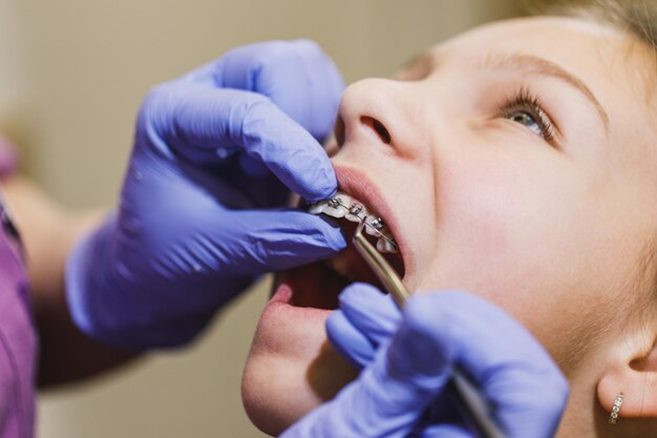When it comes to achieving a confident smile, metal dental braces often come to mind. This guide demystifies the journey, offering insights into the orthodontic metal braces process—detailing benefits, challenges, and care tips without overwhelming with jargon.
I. Introduction to Metal Dental Braces
Metal braces for teeth have been a reliable dental solution for decades. They stand as the cornerstone of orthodontic care, known for their effectiveness in improving crooked or crowded teeth. This guide introduces readers to the world of braces, specifically metal braces for teeth. We aim to offer clarity, answering common questions and misconceptions surrounding the installation and care of steel braces for teeth. By the end of this read, you will have a fuller understanding of how these braces can improve dental structures and offer lifelong benefits.
II. Understanding Metal Dental Braces
The purpose of brackets teeth braces is to slowly and gently move teeth into their correct positions. They consist of several components which work in tandem to make this happen. First, there are the brackets that attach to the teeth. Then, there are archwires that connect to these brackets, providing the gentle pressure required to move the teeth. Small rubber bands, known as ligatures, hold the archwires to the brackets. Together, these parts form a system that helps teeth achieve optimal alignment over time.
By understanding how orthodontic metal braces operate, you’ll better appreciate their role in creating healthy, beautiful smiles.
III. Who Benefits from Metal Dental Braces?
Metal dental braces are designed to address a variety of dental issues. These include crowded teeth, overbites, underbites, and gaps between teeth. They are suitable for people of all ages—children, teenagers, and even adults seeking a straighter smile. Metal dental retainers often follow the removal of braces to maintain the new alignment. Essentially, anyone experiencing significant alignment challenges or bite issues is a potential candidate for these braces. Consult with an orthodontist to determine if steel braces for teeth are ideal for you.
IV. The Process of Getting Metal Braces
The journey of getting metal dental braces often begins with consultations. During these meetings, orthodontists assess your dental structure and discuss possible treatment plans. Next comes the fitting of the braces: brackets are bonded to your teeth, and archwires are fitted.
Adjustments are essential; you’ll regularly visit the orthodontist for tightening, ensuring the braces do their job effectively. Many find the initial sensation strange, but most adapt within a few days. Each step moves you closer to that dream smile.
V. The Evolution and Benefits of Metal Braces
Over time, metal braces for teeth have become more comfortable and visually appealing. They are incredibly durable, standing up to the rigors of daily life and requiring fewer replacements. While ceramic braces for teeth might be less visible, metal dental braces remain cost-effective and efficient. Their structure makes them one of the strongest kinds of braces for teeth, ideal for complex dental cases.
VI. Challenges & Side Effects of Metal Braces
Adjusting to metal dental braces designs involves some challenges. Initial discomfort is common, especially after adjustments. Dietary changes are necessary too; sticky and hard foods can damage braces. Oral hygiene becomes critical—brushing and flossing can be tricky but are vital to prevent cavities.
- Maintain regular dental check-ups.
- Use a soft toothbrush for cleaning around brackets.
Nevertheless, the psychological benefits post-treatment, such as improved self-esteem, outweigh these initial hurdles.
VII. Comprehensive Care for Metal Braces
Proper care involves diligent cleaning methods to get rid of food particles. Brush gently around each bracket, and floss daily using special floss designed for braces.
- Avoid hard candies, nuts, and sticky toffees.
- Incorporate soft foods like yogurt and scrambled eggs into your diet.
Should emergencies like a loose bracket occur, contact your orthodontist promptly to address the issue.
VIII. Expected Timeline and Results
The timeframe for treatment varies, typically ranging from 18 to 24 months. Individual factors, such as diligence in following care guides, can influence this duration. Once removed, retainers help maintain corrected positions, leading to a satisfying, enduring smile.
IX. Comparing Different Types of Braces for Teeth
Metal dental braces are just one type among many. When compared to ceramic braces for teeth and clear aligners, metal options are more pronounced but also more robust and cost-effective. They are preferred for serious alignment corrections where durability is key.
X. Cost and Financial Considerations
The dental metal braces price varies based on complexity, location, and orthodontist experience. Insurance might cover part of the costs, and many clinics offer payment plans to ease financial strain.
Discuss options with your provider to ensure affordability and value for your investment.
XI. Navigating Life with Metal Braces
Living with metal dental braces involves simple adjustments. Keep waxing handy to cover sharp areas that cause irritation, and rinse with salt water to soothe any discomfort. Staying motivated is essential; remember, each day with braces brings you closer to your goal.
XII. Conclusion and Encouragement for Prospective Patients
In sum, metal dental braces offer a proven path to a healthier smile. Despite some challenges, the benefits of a straight, confident smile outweigh temporary discomfort. For those considering braces, take comfort in knowing you’re investing in long-term oral health and aesthetics—one step at a time.

